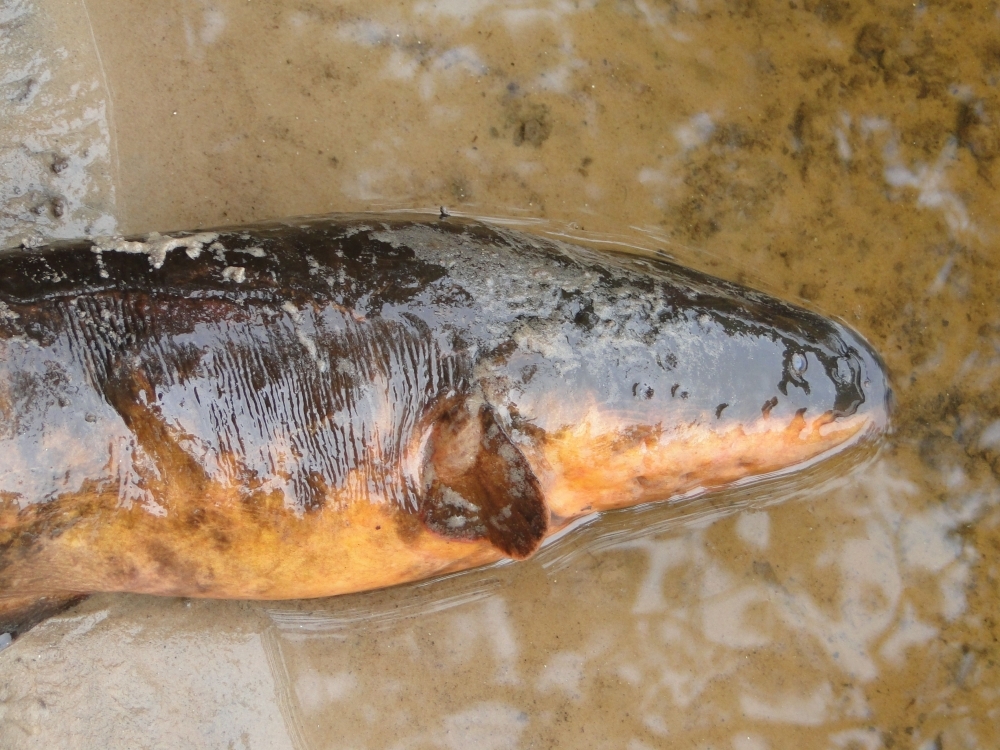


Electric eels of the species Electrophorus varii feed on other fish, especially those habitually hunted by larger predators such as caimans and giant river otters. Hunting tactics enable them to maintain the same diet in the wet and dry seasons alike (photo: researchers’ archive)
Published on 09/28/2021
By André Julião | Agência FAPESP – An article published in the journal Neotropical Ichthyology reports the most robust research findings ever on the feeding ecology of electric eels in the wild. The authors describe how the stomachs of 43 specimens of Electrophorus varii, a species endemic to the lowland Amazon Basin, contained mostly the remains of other fish, including some that are especially hard to swallow. The study refutes previously raised hypotheses that the fish is a generalist carnivore or even an omnivore.
The investigation was conducted by Brazilian researchers affiliated with the Chico Mendes Institute for Biodiversity Conservation (ICMBio) and the Federal University of Amapá (UNIFAP) as part of the project “Diversity and evolution of Gymnotiformes”, funded by FAPESP and led by Naércio Menezes, a researcher at the University of São Paulo’s Museum of Zoology (MZ-USP).
Conducted in partnership with the US National Museum of Natural History (NMNH), administered by the Smithsonian Institution, the project has extended knowledge of electric fish in recent years. E. varii was one of two new species described in 2019 by a group led by Carlos David de Santana, an associate researcher at NMNH (more at: agencia.fapesp.br/31386).
“There are still few studies of the biology of this fish, especially as far as its food is concerned. The research that does exist is based on observations of captive animals or anecdotal reports,” said Raimundo Nonato Gomes Mendes Júnior, an environmental analyst at ICMBio and first author of the article.
In the study, the researchers found fish in 96.6% of the stomach contents analyzed, especially catfish such as Callichthys callichthys, and cichlids such as angelfish (Pterophyllum spp). Insects and crustaceans were considered occasional or accidental prey. The fish species in question have spines and dermal plates and are typically preyed on by larger animals such as caimans and giant otters.
The researchers also found the stomach contents of one or two specimens to include a single seed of cabbage palm (Euterpe oleracea). “Electric eels have very small eyes and are practically blind. They produce a weak electric field for navigation. As they attack, they probably swallow these seeds, as well as other creatures, together with their prey. We found leaves and twigs in some stomachs, but we don’t believe these were food,” Mendes Júnior said.
Same diet, rain or shine
The specimens analyzed were collected from the Curiaú River Environmental Protection Area (APA), which is on the outskirts of Macapá, the capital of Amapá state, and home to a community of descendants of runaway slaves (quilombo). These inhabitants catch the fish on which electric eels prey, are used to their presence, and assisted with the collection of specimens.
Specimens were captured every two months throughout the year so as to be able to find out whether diet changed between the wet and dry seasons (January-June and July-December respectively). In floodplains like the study area, the rainfall regime is a key element of feeding dynamics. When water levels rise, the electric eels have more room and spread out more, making them harder to catch for predators that depend on sight such as the Xingu peacock bass (Cichla melaniae) or the various species of trahira (Hoplias spp), for example. Furthermore, they are obliged to include shrimp and other prey in their diet in the rainy season.
During the dry months, however, water levels fall and lakes and ponds form, trapping the fish and facilitating their capture by predators. Nevertheless, seasonality did not influence diet for the electric eels analyzed in the study. “Their diet didn’t change during the year,” Mendes Júnior said. “Our hypothesis is that their localization and hunting tactics, which don’t depend on vision, eliminate obstacles to feeding on fish all year long.”
Electric eels may form groups to hunt and even paralyze prey at a distance with strong electric discharges, which in the species studied can reach 650 volts. In addition, they rise to the surface to breathe and can therefore prey on catfish and other species that live in shallow water with little oxygen.
The researchers also found that juvenile and adult specimens (40 cm-1.80 m in length) had basically the same diet. Only the size of prey differed. They had relatively short intestines, a trait of carnivorous species, again refuting arguments that electric eels are omnivorous.
“Knowledge of the species’ biology is fundamental to the formulation of protection strategies and to ensure that future generations of humans will be able to encounter electric eels not only in zoos and aquaria but also in their natural habitat,” Mendes Júnior said.
The article “Feeding ecology of electric eel Electrophorus varii (Gymnotiformes: Gymnotidae) in the Curiaú River Basin, Eastern Amazon” by Raimundo Nonato Gomes Mendes-Júnior, Júlio César Sá-Oliveira, Huann Carllo Gentil Vasconcelos, Carlos Eduardo Costa-Campos and Andrea Soares Araújo is at: www.scielo.br/scielo.php?script=sci_arttext&pid=S1679-62252020000300202&tlng=en.
Source: https://agencia.fapesp.br/36946